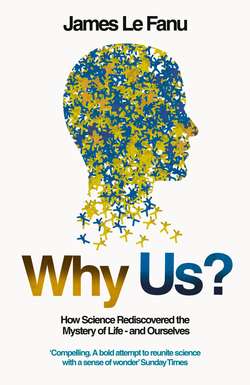Читать книгу Why Us?: How Science Rediscovered the Mystery of Ourselves - James Fanu Le - Страница 7
TABLE 1
ОглавлениеScience Triumphant 1945–2001: Thirty Definitive Moments
| 1945 | The atom bomb: Hiroshima and Nagasaki |
| 1946 | The electron microscope reveals the internal structure of the cell |
| 1947 | The invention of the transistor launches the Electronic Age |
| 1953 | Theory of formation of the chemical elements of life by nuclear fusion within stars |
| 1953 | The laboratory simulation of the ‘origin of life’ |
| 1953 | James Watson and Francis Crick discover the Double Helix |
| 1955 | The first polio vaccine |
| 1957 | The Soviet Union launches Sputnik and the epoch of planetary exploration |
| 1960 | The oral contraceptive |
| 1961 | The Genetic Code deciphered |
| 1965 | The theory of the Big Bang confirmed by discovery of cosmic microwave background radiation |
| 1967 | The first heart transplant |
| 1969 | US astronaut Neil Armstrong becomes the first man on the moon |
| 1969 | James Lovelock proposes theory of a life-sustaining atmosphere |
| 1973 | The advent of genetic engineering |
| 1973 | The invention of magnetic resonance imaging of the brain |
| 1974 | The discovery of ‘Lucy’, Australopithecus afarensis, dated 4 million years BC |
| 1974 | The first Grand Unified Theory of particle physics |
| 1977 | The first complete genetic sequence of an organism |
| 1977 | The first personal computer designed for the mass market |
| 1979 | Voyagers I and II relay data from Jupiter, Saturn, Uranus and Neptune |
| 1979 | The first ‘test tube baby’ |
| 1980 | The asteroid impact hypothesis of the mass extinction of dinosaurs |
| 1984 | The discovery of ‘Turkana Boy’, the first complete skeleton of Homo erectus, dated 1.5 million years BC |
| 1984 | Confirmation of theory of plate tectonics |
| 1987 | Formulation of the ‘out of Africa’ hypothesis of human evolution |
| 1989 | Launch of world wide web |
| 1990 | The Decade of the Brain |
| 1999 | The Hubble space telescope observes the birth of stars in the constellation Taurus |
| 2001 | Publication of the Human Genome |
The triumph of science, one might suppose, is virtually complete. What, during these times, have we learned from the humanities – philosophy, say, theology or history – that begins to touch the breadth and originality of this scientific achievement and the sheer extraordinariness of its insights? What, one might add, have the humanities done that begins to touch the medical therapeutic revolution of the post-war years or the wonders of modern technology?
That history of our universe as revealed in the recent past draws on many disciplines: cosmology and astronomy obviously, the earth and atmospheric sciences, biology, chemistry and genetics, anthropology and archaeology, and many others. But science is also a unified enterprise, and these areas of enquiry all ‘hang together’ to reveal the coherent story outlined above. There remained, however, two great unknowns, two final obstacles to a truly comprehensive theory that would also explain our place in that universe.
The first is how it is that we, like all living things, reproduce our kind with such precision from one generation to the next. The ‘instructions’, as is well recognised, come in the form of genes strung out along the two intertwining strands of the Double Helix in the nucleus of every cell. But the question still remained: How do those genes generate that near-infinite diversity and beauty of form, shape and size, and behaviour that distinguish one form of life from another? How do they fashion from a single fertilised human egg the unique physical features and mind of each one of us?
The second of these ‘great unknowns’ concerned the workings of the brain, and the human brain in particular. To be sure, neurologists have over the past hundred years identified the functions of its several parts – with the frontal lobes as the ‘centre’ of rational thought and emotion, the visual cortex at the back, the speech centre in the left hemisphere and so on. But again the question remained: How does the electrical firing of the brain’s billions of nerves ‘translate’ into our perception of the sights and sounds of the world around us, our thoughts and emotions and the rich inner landscape of personal memories?
These two substantial questions had remained unresolved because both the Double Helix and the brain were inaccessible to scientific scrutiny: the Double Helix, with its prodigious amount of genetic information, comes packed within the nucleus of the cell, a mere one five thousandth of a millimetre in diameter; while the blizzard of electrical activity of the billions of neurons of the brain is hidden within the confines of the bony vault of the skull. But then, in the early 1970s, a series of technical innovations would open up first the Double Helix and then the brain to scientific investigation, with the promise that these final obstacles to our scientific understanding of ourselves might soon be overcome. We will briefly consider each in turn.
